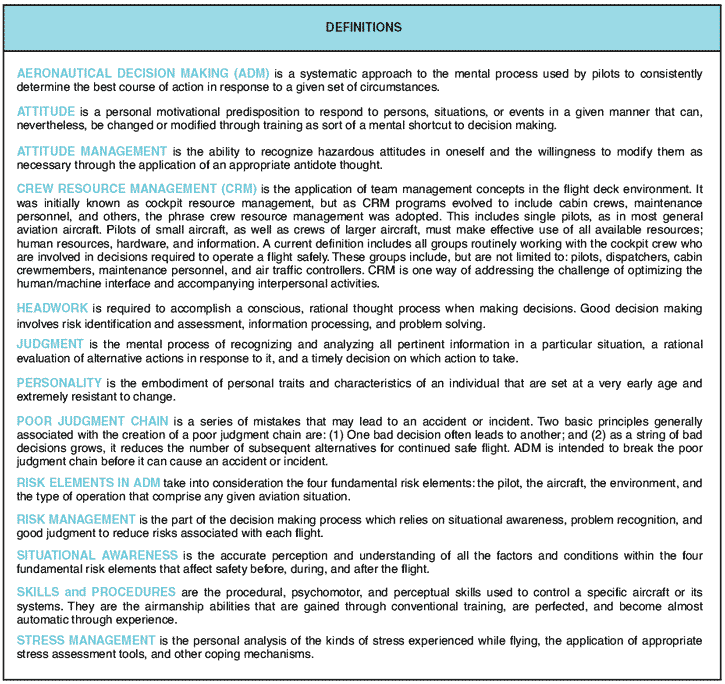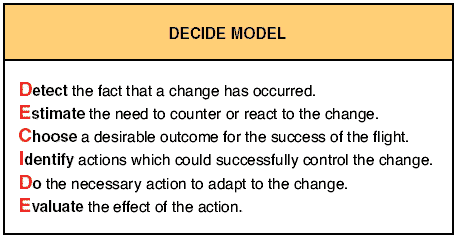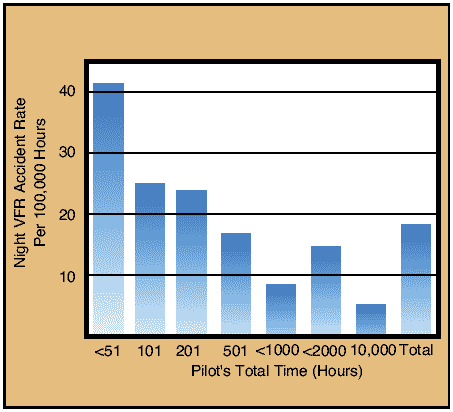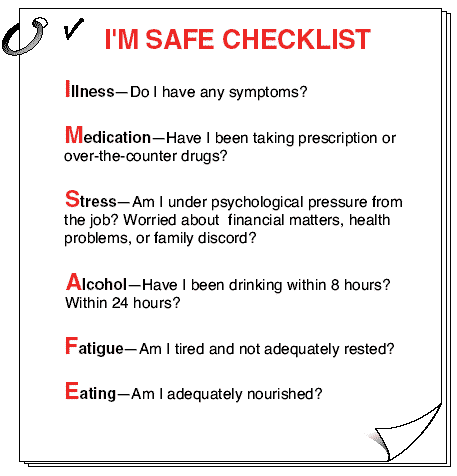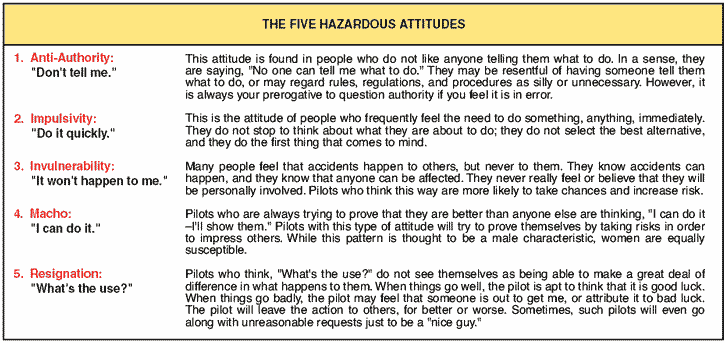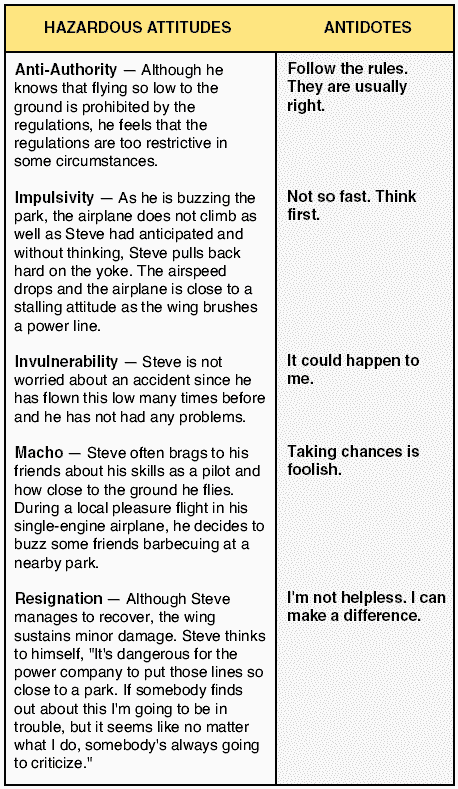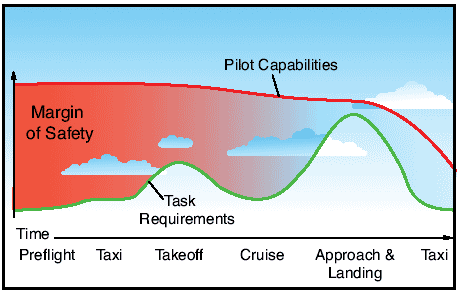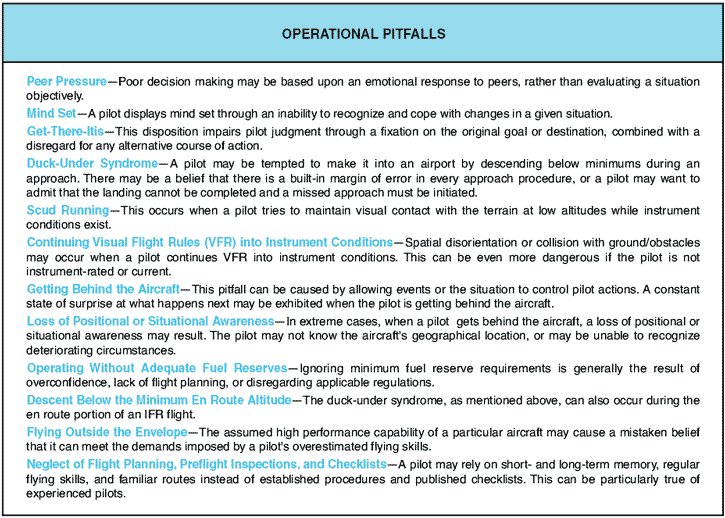

Aeronautical Decision MakingAeronautical decision making (ADM) is a systematic approach to the mental process used by airplane pilots to consistently determine the best course of action in response to a given set of circumstances. The importance of learning effective ADM skills cannot be overemphasized. While progress is continually being made in the advancement of pilot training methods, airplane equipment and systems, and services for pilots, accidents still occur. Despite all the changes in technology to improve flight safety, one factor remains the same the human factor. It is estimated that approximately 75 percent of all aviation accidents are human factors related. Historically, the term “pilot error” has been used to describe the causes of these accidents. Pilot error means that an action or decision made by the pilot was the cause, or a contributing factor that led to the accident. This definition also includes the pilot’s failure to make a decision or take action. From a broader perspective, the phrase “human factors related” more aptly describes these accidents since it is usually not a single decision that leads to an accident, but a chain of events triggered by a number of factors. The poor judgment chain, sometimes referred to as the “error chain,” is a term used to describe this concept of contributing factors in a human factors-related accident. Breaking one link in the chain normally is all that is necessary to change the outcome of the sequence of events. The following is an example illustrating the poor judgment chain. A private pilot with around 350 hours was ferrying an airplane cross-country to a new owner. Due to time constraints, the pilot skipped dinner the night before and had no breakfast on the morning of the flight. The pilot planned to have lunch around A descent was begun from 9,500 feet, about 20 miles from the chosen fuel stop, due to haze and unfamiliarity with the area. When the airplane arrived at pattern altitude, the pilot could not find the airport. The pilot then circled north of the town, then back over the town, then flew to the west, then turned back to the east. The pilot decided to check for airport information in the Airport/Facility Directory, which was on the rear seat and not readily available. Power had not been increased since the descent to pattern altitude, and the pilot had been holding back pressure on the yoke. While attempting to retrieve the Airport/Facility Directory, a loud “bang” was heard. Looking up, the pilot discovered the airplane was only about 200 feet above ground level. Increasing power, the pilot climbed and located the airport. After landing, it was discovered a fiberglass antenna had been hit, which damaged the leading edge of the left wing. By discussing the events that led to this accident, it can be understood how a series of judgmental errors contributed to the final outcome of this flight. For example, one of the first elements that affected the pilot’s flight was fatigue. The pilot understood that fatigue and hunger could affect the ability to fly safely, but let the desire to stay on schedule override the concern for a safe flight. Next, the rush to get airborne led the pilot to skip or postpone necessary aspects of preflight planning. Research before takeoff, with a quick review before descent, could have ensured a clear mental picture of the location of the airport in relation to the town. Copying relevant information from flight guides and other information sources is part of careful preflight planning. Studying the aeronautical charts and checking the Notices to Airmen (NOTAM) beforehand would have alerted the pilot to towers, terrain, and other obstructions in the vicinity of the airport. Even without proper planning before the flight, good cockpit resource management and organization would have had the flight guide and any other necessary information near at hand, perhaps with the relevant pages flagged. Approaching the airport environment and flying around the area at traffic pattern altitude in hazy conditions could have interfered with other air traffic, and the potential for a midair collision is obvious. In all circumstances, the pilot’s first duty is to fly the airplane. Clearly that would include adjusting the power, setting the trim, and keeping track of altitude. This pilot was extremely fortunate—the outcome could easily have been fatal. On numerous occasions during the flight, the pilot could have made effective decisions that would have broken the chain of error and prevented this accident. Making sound decisions is the key to preventing accidents. Traditional pilot training has emphasized flying skills, knowledge of the airplane, and familiarity with regulations. ADM training focuses on the decision-making process and the factors that affect a pilot’s ability to make effective choices. Origins of ADM training The airlines developed some of the first training programs that focused on improving aeronautical decision making. Human factors-related accidents motivated the airline industry to implement crew resource management (CRM) training for flight crews. The focus of CRM programs is the effective use of all available resources; human resources, hardware, and information. Human resources include all groups routinely working with the cockpit crew (or pilot) who are involved in decisions that are required to operate a flight safely. These groups include, but are not limited to: dispatchers, cabin crewmembers, maintenance personnel, and air traffic controllers. Although the CRM concept originated as airlines developed ways of facilitating crew cooperation to improve decision making in the cockpit, CRM principles, such as workload management, situational awareness, communication, the leadership role of the captain, and crewmember coordination have direct application to the general aviation cockpit. This also includes single pilot operations since pilots of small airplanes, as well as crews of larger airplanes, must make effective use of all available resources—human resources, hardware, and information. AC 60-22, Aeronautical Decision Making, provides background references, definitions, and other pertinent information about ADM training in the general aviation environment.
Figure 1: These terms are used in AC 60-22 to explain concepts used in ADM training. The decision-making process An understanding of the decision-making process provides a pilot with a foundation for developing ADM skills. Some situations, such as engine failures, require a pilot to respond immediately using established procedures with little time for detailed analysis. Traditionally, pilots have been well trained to react to emergencies, but are not as well prepared to make decisions requiring a more reflective response. Typically during a flight, there is time to examine any changes that occur, gather information, and assess risk before reaching a decision. The steps leading to this conclusion constitute the decision-making process. Defining the problem Problem definition is the first step in the decision-making process. Defining the problem begins with recognizing that a change has occurred or that an expected change did not occur. A problem is perceived first by the senses, then is distinguished through insight and experience. These same abilities, as well as an objective analysis of all available information, are used to determine the exact nature and severity of the problem. One critical error that can be made during the decision-making process is incorrectly defining the problem. For example, a low oil pressure reading could indicate that the engine is about to fail and an emergency landing should be planned, or it could mean that the oil pressure sensor has failed. The actions to be taken in each of these circumstances would be significantly different. Fixating on a problem that does not exist can divert attention from important tasks. The pilot’s failure to maintain an awareness of the circumstances regarding the flight now becomes the problem. This is why once an initial assumption is made regarding the problem, other sources must be used to verify that the conclusion is correct. While on a cross-country flight, a pilot discovered that fuel consumption was significantly higher than predicted during flight planning. By noticing this discrepancy, change has been recognized. Based on insight, cross-country flying experience, and knowledge of airplane systems, the pilot considers the possibility that there might be enough fuel to reach the destination. Factors that may increase the fuel burn rate could include environmental factors, such as higher-than-expected headwinds and lower-than-expected groundspeed. To determine the severity of the problem, recalculate the fuel consumption and reassess fuel requirements. Choosing a course of action After the problem has been identified, the pilot must evaluate the need to react to it and determine the actions that may be taken to resolve the situation in the time available. The expected outcome of each possible action should be considered and the risks assessed before deciding on a response to the situation. The pilot determines there is insufficient fuel to reach the destination, and considers other options, such as turning around and landing at a nearby airport that has been passed, diverting off course, or landing prior to the destination at an airport on the route. The expected outcome of each possible action must be considered along with an assessment of the risks involved. After studying the aeronautical chart, the pilot concludes that there is an airport that has fueling services within the remaining fuel range along the route. The time expended for the extra fuel stop is a worthwhile investment to ensure a safe completion of the flight.
Implementing the decision and evaluating the outcome Although a decision may be reached and a course of action implemented, the decision-making process is not complete. It is important to think ahead and determine how the decision could affect other phases of the flight. As the flight progresses, the pilot must continue to evaluate the outcome of the decision to ensure that it is producing the desired result. To implement the decision, the pilot determines the necessary course changes and calculates a new estimated time of arrival, as well as contacts the nearest flight service station to amend the flight plan and check weather conditions at the fuel stop. Proceeding to the airport, continue to monitor the groundspeed, fuel status, and the weather conditions to ensure that no additional steps need to be taken to guarantee the safety of the flight. The decision-making process normally consists of several steps before choosing a course of action. To help remember the elements of the decision-making process, a six-step model has been developed using the acronym “DECIDE.”
Figure 2: The DECIDE model can provide a framework for effective decision making. Risk management During each flight, decisions must be made regarding events involving interactions between the four risk elements—the pilot in command, the airplane, the environment, and the operation. The decision-making process involves an evaluation of each of these risk elements to achieve an accurate perception of the flight situation.
Figure 3: When situationally aware, the pilot has an overview of the total operation and is not fixated on one perceived significant factor. One of the most important decisions that a pilot in command must make is the go/no-go decision. Evaluating each of these risk elements can help in deciding whether a flight should be conducted or continued. Below is a review of the four risk elements and how they affect decision making regarding the following situations. Pilot—A pilot must continually make decisions about competency, condition of health, mental and emotional state, level of fatigue, and many other variables. For example, a pilot may be called early in the morning to make a long flight. If a pilot has had only a few hours of sleep and is concerned that the congestion being experienced could be the onset of a cold, it would be prudent to consider if the flight could be accomplished safely. A pilot had only 4 hours of sleep the night before. The boss then asked the pilot to fly to a meeting in a city 750 miles away. The reported weather was marginal and not expected to improve. After assessing fitness as a pilot, it was decided that it would not be wise to make the flight. The boss was initially unhappy, but later convinced by the pilot that the risks involved were unacceptable. Airplane—A pilot will frequently base decisions on the evaluations of the airplane, such as performance, equipment, or airworthiness. During a preflight, a pilot noticed a small amount of oil dripping from the bottom of the cowling. Although the quantity of oil seemed insignificant at the time, the pilot decided to delay the takeoff and have a mechanic check the source of the oil. The pilot’s good judgment was confirmed when the mechanic found that one of the oil cooler hose fittings was loose. Environment—This encompasses many elements not pilot or airplane related. It can include such factors as weather, air traffic control, navaids, terrain, takeoff and landing areas, and surrounding obstacles. Weather is one element that can change drastically over time and distance. A pilot was landing a small airplane just after a heavy jet had departed a parallel runway. The pilot assumed that wake turbulence would not be a problem since landings had been performed under similar circumstances. Due to a combination of prevailing winds and wake turbulence from the heavy jet drifting across the landing runway, the airplane made a hard landing. The pilot made an error when assessing the flight environment. Operation—The interaction between the pilot, airplane, and the environment is greatly influenced by the purpose of each flight operation. The pilot must evaluate the three previous areas to decide on the desirability of undertaking or continuing the flight as planned. It is worth asking why the flight is being made, how critical is it to maintain the schedule, and is the trip worth the risks? On a ferry flight to deliver an airplane from the factory, in marginal weather conditions, the pilot calculated the groundspeed and determined that the airplane would arrive at the destination with only 10 minutes of fuel remaining. The pilot was determined to keep on schedule by trying to “stretch” the fuel supply instead of landing to refuel. After landing with low fuel state, the pilot realized that this could have easily resulted in an emergency landing in deteriorating weather conditions. This was a chance that was not worth taking to keep the planned schedule.
Assessing risk Examining National Transportation Safety Board (NTSB) reports and other accident research can help assess risk more effectively. For example, the accident rate during night VFR decreases by nearly 50 percent once a pilot obtains 100 hours, and continues to decrease until the 1,000-hour level. The data suggest that for the first 500 hours, pilots flying VFR at night might want to establish higher personal limitations than are required by the regulations and, if applicable, apply instrument flying skills in this environment.
Figure 4: Statistical data can identify operations that have more risk involved. Studies also indicate the types of flight activities that are likely to result in the most serious accidents. The majority of fatal general aviation accidents fall under the categories of takeoff/initial climb, maneuvering flight, approaches, and weather. Delving deeper into accident statistics can provide some important details that can help in understanding the risks involved with specific flying situations. For example, maneuvering flight is one of the largest single producers of fatal accidents. In the approach phase, fatal accidents often happen at night or in IFR conditions. Takeoff/initial climb accidents frequently are due to the pilot’s lack of awareness of the effects of density altitude on airplane performance or other improper takeoff planning resulting in loss of control during, or shortly after takeoff. The majority of weather-related accidents occur after attempted VFR flight into IFR conditions. Factors affecting decision making It is important to point out the fact that being familiar with the decision-making process does not ensure the good judgment to be a safe pilot. The ability to make effective decisions as pilot in command depends on a number of factors. Some circumstances, such as the time available to make a decision may be beyond a pilot’s control. However, one can learn to recognize those factors that can be managed, and learn skills to improve decision-making ability and judgment. Pilot self-assessment The pilot in command of an airplane is directly responsible for, and is the final authority as to, the operation of that airplane. To effectively exercise that responsibility and make effective decisions regarding the outcome of a flight, a pilot should be aware of personal limitations. Performance during a flight is affected by many factors, such as health, recency of experience, knowledge, skill level, and attitude. Exercising good judgment begins prior to taking the controls of an airplane. Often, pilots thoroughly check their airplane to determine airworthiness, yet do not evaluate their own fitness for flight. Just as a checklist is used when preflighting an airplane, a personal checklist based on such factors as experience, currency, and comfort level can help determine if a pilot is prepared for a particular flight. Specifying when refresher training should be accomplished and designating weather minimums that may be higher than those listed in Title 14 of the Code of Federal Regulations (14 CFR) part 91 are elements that may be included on a personal checklist. In addition to a review of personal limitations, use the I’M SAFE Checklist to further evaluate fitness for flight.
Figure 5: Prior to flight, pilot fitness should be assessed the same as the airplane’s airworthiness is evaluated. Recognizing hazardous attitudes Being fit to fly depends on more than just a pilot’s physical condition and recency of experience. For example, attitude will affect the quality of decisions. Attitude can be defined as a personal motivational predisposition to respond to persons, situations, or events in a given manner. Studies have identified five hazardous attitudes that can interfere with the ability to make sound decisions and exercise authority properly.
Figure 6: The pilot should examine decisions carefully to ensure that the choices have not been influenced by a hazardous attitude. Hazardous attitudes can lead to poor decision making and actions that involve unnecessary risk. The pilot must examine decisions carefully to ensure that the choices have not been influenced by hazardous attitudes and be familiar with positive alternatives to counteract the hazardous attitudes. These substitute attitudes are referred to as antidotes. During a flight operation, it is important to be able to recognize a hazardous attitude, correctly label the thought, and then recall its antidote.
Figure 7: The pilot must be able to identify hazardous attitudes and apply the appropriate antidote when needed. Stress management Everyone is stressed to some degree almost all the time. A certain amount of stress is good since it keeps a person alert and prevents complacency. However, effects of stress are cumulative and, if not coped with adequately, they eventually add up to an intolerable burden. Performance generally increases with the onset of stress, peaks, and then begins to fall off rapidly as stress levels exceed a person’s ability to cope. The ability to make effective decisions during flight can be impaired by stress. Factors, referred to as stressors, can increase a pilot’s risk of error in the cockpit.
Figure 8: The three types of stressors that can affect a pilot’s performance. There are several techniques to help manage the accumulation of life stresses and prevent stress overload. For example, including relaxation time in a busy schedule and maintaining a program of physical fitness can help reduce stress levels. Learning to manage time more effectively can help avoid heavy pressures imposed by getting behind schedule and not meeting deadlines. Take a self-assessment to determine capabilities and limitations and then set realistic goals. In addition, avoiding stressful situations and encounters can help to cope with stress. Use of resources To make informed decisions during flight operations, a pilot must become aware of the resources found both inside and outside the cockpit. Since useful tools and sources of information may not always be readily apparent, learning to recognize these resources is an essential part of ADM training. Resources must not only be identified, but a pilot must develop the skills to evaluate whether there is time to use a particular resource and the impact that its use will have upon the safety of flight. For example, the assistance of air traffic control (ATC) may be very useful if a pilot becomes lost. However, in an emergency situation when action needs be taken quickly, time may not be available to contact ATC immediately. Internal resources Internal resources are found in the cockpit during flight. Since some of the most valuable internal resources are ingenuity, knowledge, and skill, a pilot can expand cockpit resources immensely by improving these capabilities. This can be accomplished by frequently reviewing flight information publications, such as the CFRs and the Aeronautical Information Manual (AIM), as well as by pursuing additional training. A thorough understanding of all the equipment and systems in the airplane is necessary to fully utilize all resources. For example, advanced navigation and autopilot systems are valuable resources. However, if pilots do not fully understand how to use this equipment, or they rely on it so much that they become complacent, it can become a detriment to safe flight. Checklists are essential cockpit resources for verifying that the airplane instruments and systems are checked, set, and operating properly, as well as ensuring that the proper procedures are performed if there is a system malfunction or in-flight emergency. In addition, the Airplane Flight Manual/Pilot’s Operating Handbook (AFM/POH), which is required to be carried on board the airplane, is essential for accurate flight planning and for resolving in-flight equipment malfunctions. Other valuable cockpit resources include current aeronautical charts and publications, such as the Airport/Facility Directory. Passengers can also be a valuable resource. Passengers can help watch for traffic and may be able to provide information in an irregular situation, especially if they are familiar with flying. A strange smell or sound may alert a passenger to a potential problem. A pilot in command should brief passengers before the flight to make sure that they are comfortable voicing any concerns. External resources Possibly the greatest external resources during flight are air traffic controllers and flight service specialists. ATC can help decrease pilot workload by providing traffic advisories, radar vectors, and assistance in emergency situations. Flight service stations can provide updates on weather, answer questions about airport conditions, and may offer direction-finding assistance. The services provided by ATC can be invaluable in enabling a pilot to make informed in-flight decisions. Workload management Effective workload management ensures that essential operations are accomplished by planning, prioritizing, and sequencing tasks to avoid work overload. As experience is gained, a pilot learns to recognize future workload requirements and can prepare for high workload periods during times of low workload. Reviewing the appropriate chart and setting radio frequencies well in advance of when they are needed helps reduce workload as the flight nears the airport. In addition, a pilot should listen to ATIS, ASOS, or AWOS, if available, and then monitor the tower frequency or CTAF to get a good idea of what traffic conditions to expect. Checklists should be performed well in advance so there is time to focus on traffic and ATC instructions. These procedures are especially important prior to entering a high-density traffic area, such as Class B airspace. To manage workload, items should be prioritized. During any situation, and especially in an emergency, remember the phrase “aviate, navigate, and communicate.” This means that the first thing the pilot should do is to make sure the airplane is under control. Then begin flying to an acceptable landing area. Only after the first two items are assured should the pilot try to communicate with anyone. Another important part of managing workload is recognizing a work overload situation. The first effect of high workload is that the pilot begins to work faster. As workload increases, attention cannot be devoted to several tasks at one time, and the pilot may begin to focus on one item. When a pilot becomes task saturated, there is no awareness of inputs from various sources, so decisions may be made on incomplete information, and the possibility of error increases.
Figure 9: Accidents often occur when flying task requirements exceed pilot capabilities. The difference between these two factors is called the margin of safety. Note that in this idealized example, the margin of safety is minimal during the approach and landing. At this point, an emergency or distraction could overtax pilot capabilities, causing an accident. When becoming overloaded, stop, think, slow down, and prioritize. It is important to understand options that may be available to decrease workload. For example, tasks such as locating an item on a chart or setting a radio frequency may be delegated to another pilot or passenger; an autopilot, if available, may be used; or ATC may be enlisted to provide assistance. Situational awareness Situational awareness is the accurate perception of the operational and environmental factors that affect the airplane, pilot, and passengers during a specific period of time. Maintaining situational awareness requires an understanding of the relative significance of these factors and their future impact on the flight. When situationally aware, the pilot has an overview of the total operation and is not fixated on one perceived significant factor. Some of the elements inside the airplane to be considered are the status of airplane systems, and also the pilot and passengers. In addition, an awareness of the environmental conditions of the flight, such as spatial orientation of the airplane, and its relationship to terrain, traffic, weather, and airspace must be maintained. To maintain situational awareness, all of the skills involved in aeronautical decision making are used. For example, an accurate perception of pilot fitness can be achieved through self-assessment and recognition of hazardous attitudes. A clear assessment of the status of navigation equipment can be obtained through workload management, and establishing a productive relationship with ATC can be accomplished by effective resource use. Obstacles to maintaining situational awareness Fatigue, stress, and work overload can cause a pilot to fixate on a single perceived important item rather than maintaining an overall awareness of the flight situation. A contributing factor in many accidents is a distraction that diverts the pilot’s attention from monitoring the instruments or scanning outside the airplane. Many cockpit distractions begin as a minor problem, such as a gauge that is not reading correctly, but result in accidents as the pilot diverts attention to the perceived problem and neglects to properly control the airplane. Complacency presents another obstacle to maintaining situational awareness. When activities become routine, there is a tendency to relax and not put as much effort into performance. Like fatigue, complacency reduces a pilot’s effectiveness in the cockpit. However, complacency is harder to recognize than fatigue, since everything is perceived to be progressing smoothly. For example, a pilot has not bothered to calculate the CG of the airplane because it has never been a problem. Without the pilot realizing it, a passenger loads a heavy piece of equipment in the nose baggage compartment. The pilot notices severe nose heaviness during climb-out after takeoff, and finds it necessary to use full nose-up trim to maintain level flight. As the pilot flares for landing, the elevator reaches the stop without raising the nose enough, and the nose-first landing results in loss of the nose gear and extensive damage to the airplane. Operational pitfalls There are a number of classic behavioral traps into which pilots have been known to fall. Pilots, particularly those with considerable experience, as a rule, always try to complete a flight as planned, please passengers, and meet schedules. The basic drive to meet or exceed goals can have an adverse effect on safety, and can impose an unrealistic assessment of piloting skills under stressful conditions. These tendencies ultimately may bring about practices that are dangerous and often illegal, and may lead to a mishap. A pilot will develop awareness and learn to avoid many of these operational pitfalls through effective ADM training.
Figure 10: All experienced pilots have fallen prey to, or have been tempted by, one or more of these tendencies in their flying careers. This concludes the page on Aeronautical Decision Making. You can now check your knowledge on the FAA Flight Operations test question database or go on to the Aeromedical Factors page. |








